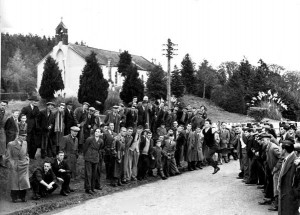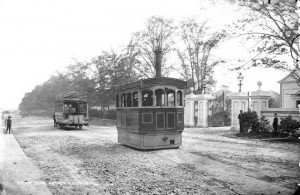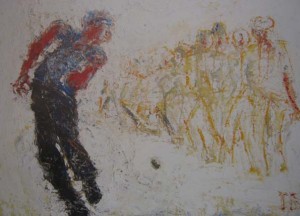Bullet-throwing in Belfast
Published in 20th Century Social Perspectives, Features, Issue 2 (March/April 2015), Volume 23
Liam O’Keeffe, Waterfall, throws during the first Munster road bowling championship in 1954 at Cloghroe, Co. Cork. Today the sport survives there, and in County Armagh. It also flourished for much of the nineteenth century around Belfast. (Fintan Lane)
‘Bullet-throwing’, as it was almost universally called in Belfast, involved the throwing of an iron ball weighing 28 ounces along a course of two to three miles. A match or ‘score’ was most often contested by single players, but doubles matches also occurred. The winner or winners were those who completed the course with the fewest throws. Large crowds assembled, often with drink taken, to watch these matches, which were also major gambling occasions.
Today the sport survives in counties Armagh and Cork, but no one has suggested that it flourished for much of the nineteenth century around Belfast. Quite to the contrary, James Kelly in his otherwise authoritative Sport in Ireland 1600–1840 (Four Courts Press, 2014) describes a once-widespread sport that was ‘in rapid retreat in the early nineteenth century’ and especially in east Ulster because of ‘economic and social change . . .’.
Belfast, as the epicentre of transformation, accordingly seems a most unlikely arena in which to find bullet-throwing flourishing. Yet a fundamental aspect of that change was massive immigration from rural handloom weaving areas, where bullet-throwing had been prevalent.
Bullet-throwing was largely seasonal. Often the first games were played on Easter Monday, with activity tailing off in late autumn. The game was played on the outskirts of the town, where you could find relatively clear roads and might evade the police. Of the 55 locations mentioned, 27, or almost half, were to the north, with the Antrim and Ballysillan roads and Ligoniel featuring significantly. There were thirteen references to the west, with the Falls and Springfield roads as particular hot spots, while the east of the town, with eleven mentions, featured almost as strongly. Only the south lagged behind, with a mere four mentions.
Substantial fines

The Antrim Road, at Chichester Park gates, on the edge of Belfast—mentioned in press reports in the 1870s and 1880s as bullet-throwing venues. (NLI)
The police operated in plain clothes. As the magistrate at the trial of seventeen-year-old Edward Morrison in 1875 said, ‘If boys like the defendant saw a policeman they would run like a redshank’. Guilt by association was enough for a conviction. There was no evidence that Morrison was bullet-throwing but, ‘As the defendant was seen in the crowd, in the eyes of the law he was as guilty as if he had been seen throwing bullets’, and he was fined 10/-.
Lookouts, markers and coat-holders were all vulnerable. Possession of a bullet was an offence and the bullet was also forfeit. The searching of Daniel McMullan and James Brady at Ballymurphy in 1869 produced the real thing in the form of a loaded pistol and powder; the detective had stumbled across would-be Fenians!
In those outer bullet-throwing zones players came into conflict with merchant villa-dwellers, who, in their hostile accounts, offered valuable evidence. One correspondent, writing in 1870, described how:
‘This afternoon when driving between Purdysburn and Shaw’s Bridge, I found three separate parties hurling these iron missiles along the centre of the road, and on nearing the bridge, one of the balls passed, with great velocity, between my pony’s legs. As I could not identify the man who threw it, I could only throw the ball into the river.’
On the Malone Road he captured another ball and delivered it to the Belfast News-letter with the comment, ‘You will observe that these balls are cast in a regular mould, which indicates that they are bought and not made by those who use them’. The editor confirmed that the bullet was ‘cast metal, admirably moulded, and weighs 1lb 12oz.’.
McQuoid vs ‘the Cork man’, December 1881
Over a period of more than 40 years bullet-throwing continued to flourish on the Antrim Road, as another angry letter in 1879 confirmed:
‘Yesterday afternoon, while walking up the Antrim Road, I counted no less than six parties of roughs indulging in this seemingly congenial pastime. The first lot were a short distance above Fortwilliam Park, the last near Thronemount.’
In December 1881, the Belfast News-letter uniquely provided a straightforward account of a major match:
‘BULLET MATCH ON THE ANTRIM ROAD
Yesterday morning at nine o’clock a bullet match came off on the Antrim Road between a local man and a man from Cork. The stakes we understand were £60 a side, and the distance was between the sixth and ninth milestones. The road during the contest was crowded. The result was a victory for the Cork champion by one throw and forty yards.’
Now we have moved further out of town; the sixth milestone is at Glengormley, so the match was played on the road from there to Antrim. It was also played at an early hour and in midwinter. Were these tactics to evade the police?
Memory of the Corkman was to survive for more than 50 years, as recounted in Ireland Saturday Night in 1936, when one ‘J.S.’ described the sport of ‘long bullets’, or ‘bullet throwing’, as being ‘formerly very common on the roads about Belfast,’ and how:
‘At Edenderry lived a celebrated bullet thrower called McQuoid. He was employed in Combe Barbour’s, and walked night and morning to and from his work. On his way he practised bullet throwing, and so became very proficient. A party rivalry had been established, and none of the exponents of the game on the Falls Road could beat McQuoid. Ultimately they brought a man from Cork who beat him in a great game played far up the Springfield Road. There was great jubilation over this victory . . .’
This account drew forth a new contribution from ‘Glen Iris’, who claimed to have seen the famous match:
‘I have a slight recollection of the bullet throwing match . . . The match was played on the Horse Shoe road up Ligoniel way. So far as I remember the Cork man beat the local by his knowledge of making his bullet shoot at an angle after touching the ground.’
He recalled a couple of lines from a children’s ditty:
‘The Cork man won, the Cork man won;
Eh, oh, bravo, the Cork man won!’
Who was the ‘Cork man’? ‘J.S.’ tells us that he ‘married a Belfast girl and settled here’. He must have played at a number of locations, yet the only contemporary evidence is for that 1881 match on the Antrim Road.
We find no more references to the sport there, but there is a rearguard survival further out. Here mass arrests became the order of the day: 50 men were charged with bullet-throwing in December 1881, and as late as 1894 another 28 were fined 10/- at Whiteabbey petty sessions. It seems to have been the kiss of death.
Policing and rival sports
More effective policing is an obvious explanation for rapid decline, but the breakneck expansion of the town must have been a major factor, as previously relatively unfrequented roads were urbanised in the building frenzy of the 1880s and 1890s. New sports such as football and cricket took rapid hold without the risks of prosecution or even persecution.
The isolated outlying mill village of Ligoniel was insulated from these factors, and the sport long retained a toehold there. Writing in 1981, Robbie Henderson recalled a needle match played on an Easter Monday, and possibly just before the First World War, between local hero John Luney and Tom Allen from Lisburn. Luney, ‘the tall dark Adonis and the favourite of the local bullet fraternity’, was a striking figure, with ‘his close-cropped hair, his strong arms, and the great leather belt around his waist. He wore plimsolls and thick bandages were wrapped round his feet, presumably to prevent him slipping on the snowy surface.’ A great deal of money had been staked on the outcome, and celebrations followed when Luney triumphed. Henderson was also witness to the last big contest at Ligoniel in the late 1920s, when local man John Stewart took on ‘the great “hammer” Peter Donnelly from Armagh’ but lost. Yet the end was in sight. Surprisingly, the police didn’t stamp it out; instead it was heavy motor traffic on the Horseshoe Road that meant ‘the continuation of the game was impossible’.
John Gray is the former Librarian of the Linen Hall Library, Belfast.
Read More: Bullet-throwing in Belfast
Further reading
R. Henderson, ‘Sport in Ligoniel: bullet throwing’, in The last of the mill villages: Ligoniel (Belfast, 1981).
F. Lane, Long bullets: a history of road bowling in Ireland (Cork, 2005).
R. Murray (ed.), ‘The Armagh bullet thrower’, Seanchais Ard Mhacha (1976).
T.G.F. Patterson, ‘Long bullets in County Armagh’, Ulster Journal of Archaeology (3rd ser.) 9 (1946).

















